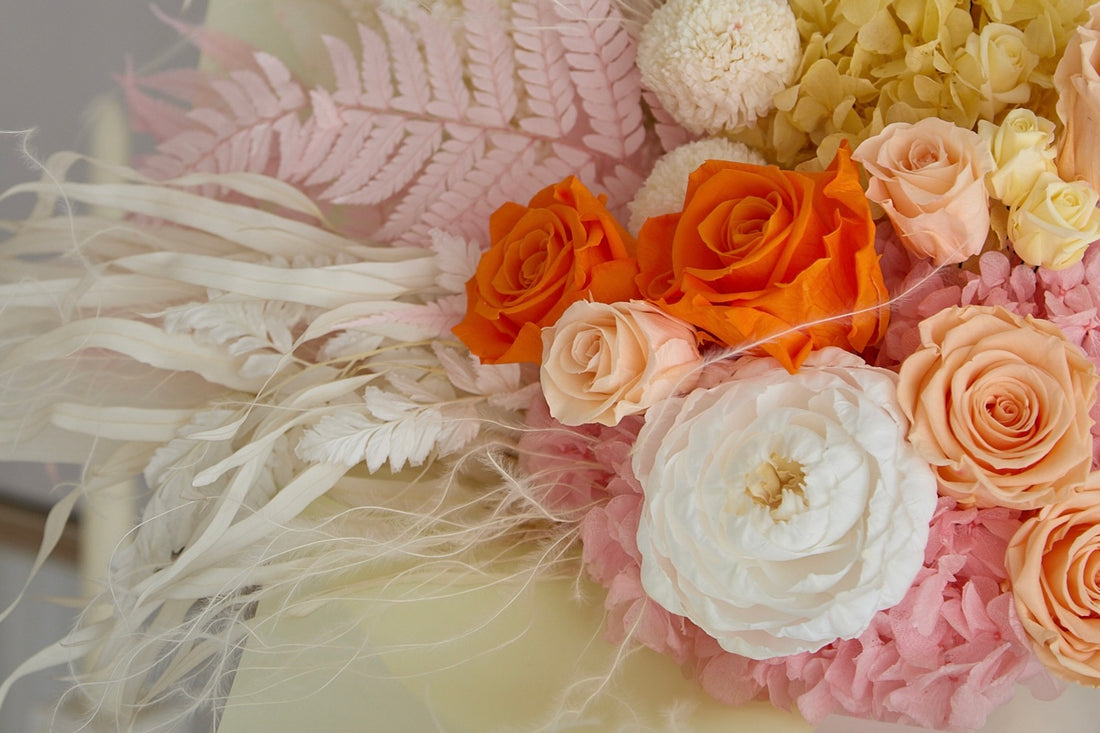When it comes to long-lasting floral arrangements, both dried and preserved flowers come to mind. While they are often used interchangeably in the arrangements, there are key differences between the two that we’ll break down in this blog post. Let’s explore what sets them apart, their benefits, and when to choose one over the other.

What Are Dried Flowers?
Dried flowers are exactly what they sound like - flowers that have been dried naturally. The drying process removes all moisture from the flowers, leaving them in a more brittle state, but they retain their natural shape and color. Dried flowers tend to have softer, more subdued colors than fresh ones, giving them a rustic look. However, modern farmers have learned to dye flowers in various colors to achieve vibrant brightness.

How Are Dried Flowers Made?
- Air-drying: Flowers are hung upside down in a dark, dry area until all the moisture evaporates.
- Dehydrating: Using silica gel or a dehydrator, moisture is absorbed from the flowers more quickly than air drying.

What Are Preserved Flowers?
Preserved flowers undergo a special preservation process to maintain original shape, color, and freshness for an extended period. The process involves replacing the natural sap in the flowers with a glycerin-based solution. This technique allows the flowers to maintain their vibrant color and a fresh, soft appearance, almost as if they are still alive, making them a long-lasting and low-maintenance alternative to fresh flowers and plants.

How Are Preserved Flowers Made?
- Harvesting: Flowers are picked at their peak bloom.
- Preservation: The flowers are treated with a solution of glycerin and other plant-safe ingredients to replace the natural moisture.
- Drying and Coloring: If needed, the flowers may be dyed to restore or enhance their original color.

Key Differences Between Dried and Preserved Flowers
- Appearance
- Dried Flowers: The petals may be more brittle and their natural colors are usually muted. However, with modern techniques, they can be dyed in any color to achieve a vibrant look.
- Preserved Flowers: Retain a more natural appearance with vibrant colors and a fresh-like feel. They look like freshly cut flowers.
- Longevity
- Dried Flowers: Can last several months to a year if kept away from direct sunlight and moisture.
- Preserved Flowers: Can last one to three years or even longer with proper care.
- Texture
- Dried Flowers: Are more brittle and can crumble slightly when handled.
- Preserved Flowers: Stay soft and flexible, thanks to the glycerin-based preservation process.

Combining Dried and Preserved Flowers
In our arrangements, we often blend dried and preserved flowers to achieve a mixed look that offers the best of both worlds. This combination allows for a variety of textures, colors, and lasting beauty. For example, our recently released Paris Bouquet features preserved roses from Ecuador, paired with all-time favorite dried pampas grass and other neutral florals, creating a balanced and elegant arrangement that looks fresh while still providing a rustic look.

How to Care for Dried and Preserved Flowers
- Keep Away from Direct Sunlight: Exposure to direct sunlight can cause colors to fade.
- Avoid Humidity: High moisture can lead to mold or cause the flowers to become limp.
- Dust Gently: Use a soft brush or a hairdryer on a cool, low setting to remove dust.

Both dried and preserved flowers are beautiful and durable options for long-lasting arrangements.
Now that you know the difference, which will you choose for your next arrangement?

